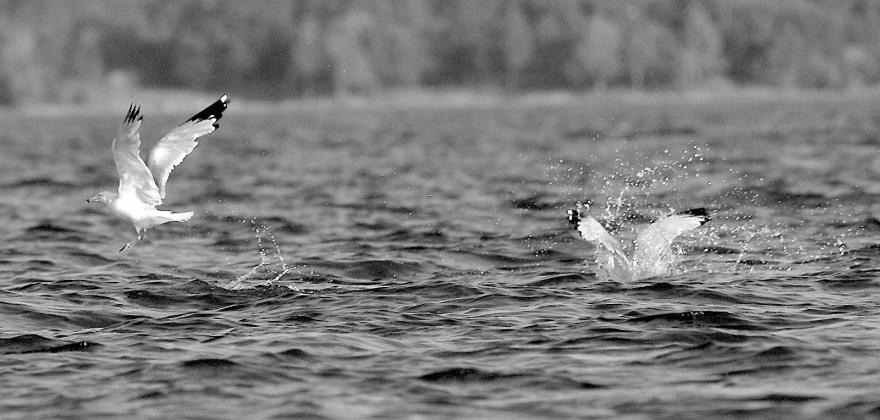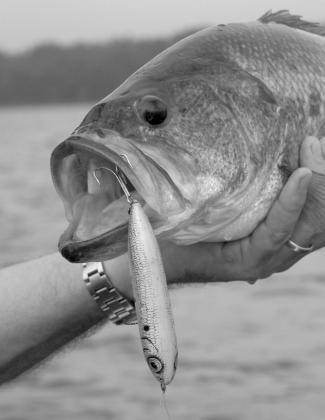The Great Outdoors
A friend and I were just about to call it quits and make a dash for the boat ramp after a tough morning of bass fishing. The big July sun climbed in the cloudless sky and there wasn’t a breath of wind to stir the sultry air. It was getting hotter by the minute and we’d both had enough.
That’s when I spotted something encouraging, roughly 75 yards way. The still water turned nervous as threadfin shad began dimpling the surface. I elbowed my friend in the side.
“Look — let’s hold on just a minute.” “Here they come.”
Within seconds the surface began to roil and swirl as a wolf pack of largemouth bass waged war on the succulent bait fish. The attack was relentless, so vicious that it sent some of the hapless shad cartwheeling across the surface in frantic attempts to find safety that wasn’t there.
Suddenly, it didn’t seem so hot outside anymore. I jumped to the front deck and quietly closed the casting gap with the trolling motor while my friend readied our rods. Mine was rigged with a Yellow Magic popper, his with a 1/4 ounce chrome Rat-L-Trap.
They were good choices. Both of us caught fish on six consecutive casts before the action momentarily waned. We duplicated the patterns and lost count of the hook ups before calling it quits shortly after noon.
Though most of the school bass were small, they were a blast to catch. More importantly, they helped salvage what started out as a really dull day.
It’s not the first time I’ve crossed paths with a burly group of school bass, and it won’t be the last. The encounter spurred the recollection of what former Bassmaster Classic champion Tommy Martin of Milam told me years ago about the big water bullies.
“School bass typically aren’t that big, but they can be a lot of fun to catch when they are going good,” he said. “I usually won’t chase them in tournaments, but they have saved my butt more than once on guide trips when the fishing got slow.”
Eating Machines
Venture onto any reputable bass lake over the next few months and you might witness such a blood bath first hand. Just don’t be surprised if you hear it before you see it.
Schoolies are highly competitive and super aggressive when the dinner bell rings. When one fish plows into a cloud of shad, others are prone to join in the massacre. At times, the feeding frenzy can be so intense that the commotion can be heard from a considerable distance on a windless day.
Most schoolies are typically pretty small, say 1-2 pounds. But that’s not always the case. Tim Boatman and I once ran into an army of thick-shouldered school bass at Lake Baccarac in Mexico. The fish had pinned a school of shad against a steep, rocky shoreline and were munching them at will. Several of shad actually leaped out of the water and onto the bank to reach safety at the last second.
We caught dozens fish out a 20 yard stretch before the schooling activity finally subsided. There wasn’t a dink in the bunch. Most were in the 3-5 pound range.
What Triggers It
No one knows for certain what compels game fish like black bass, white bass and stripers to school on the surface, but some fisheries experts have a pretty good idea. TPWD fisheries biologist Todd Driscoll believes the phenomenon is spurred by two things: where the shad are positioned in the water column and the bass high metabolic rate during the warmer months of the year.
Driscoll says black bass naturally need more to eat when water temperatures are warm and they don’t mind expending the energy to chase down shad to satisfy their appetite.
“You will occasionally see fish schooling on the surface year-round, but it seems to bemost pronounced during summer and early fall,” he said.
Driscoll added that he believes the violent feeding activity seen on the surface represents only a fraction of the actual schooling activity that goes on out there. Plenty goes on go beneath the surface, too.
Finding some success with school bass isn’t rocket science. Here are a few tips to follow:
* Keep Your Distance: School bass can be extremely boat shy. When bass are schooling on the surface, always try keep the boat positioned as far away from the activity as possible. The farther you stay away from the school, the less risk of spooking them.
* Stay Quiet: It’s never a good idea to approach active school bass using the outboard engine. The drone of the engine will likely spook them. Use trolling motor to close the gap. Better yet, use any wind to your advantage; allow the wind to blow the boat towards the schoolies if you can.
* Best Baits: Use lures that simulate prey. School bass feed predominantly on shad. A chrome topwater like the Pop R or Yellow Magic is hard to beat. Other favorites are the Rat-L-Trap, Ricky Dink, under spin and CC Spoon. Lures that can be cast long distances are best for boat shy fish.
* Bigs Down Under: School bass are generally small. Often times, however, larger fish will cruise around below the smaller schoolies and pick off wounded forage left behind. A slow sinking soft plastic like light Texas rig worm, Zoom Fluke, small swim bait or Senko are ideal for getting at them.
* Mind Your Manners: If you come across another boat working a school of active fish, the courteous thing to do is shut down the outboard immediately.
* Feathered Friends: Gulls, terns and blue herons fish for a living. If you see a group of gulls hovering just above the surface, or occasionally dipping down, there are likely shad on or near the surface. A blue heron perched on a stump in the middle of the lake or along a creek bend is another potential sign.
* Keep Binoculars Handy: Using binoculars will help you watch for schoolies or feeding birds from a considerable distance, full circle around the boat.
* Patience a Virtue: Just because schooling activity wanes in an area doesn’t mean it’s over with. Stick around and stay quiet. The fish will often times erupt again nearby.
--- Matt Williams is a freelance writer based in Nacogdoches. He can be reached by e-mail, mattwillwrite4u@yahoo.
com.




